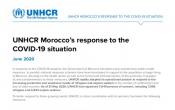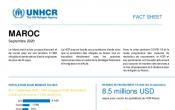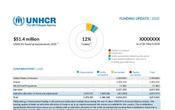Morocco
Operation: Morocco
Location
{"longitude":-7,"latitude":32,"zoom_level":5,"iso_codes":"'MAR'"}
By clicking on the icons on the map, additional information is displayed.
The boundaries and names shown and the designations used on this map do not imply official endorsement or acceptance by the United Nations.
Key Figures
| 2019 year-end results | |
| 90% | of primary school-aged children were enrolled in primary education |
| 3,600 | conditional cash grants were provided for education |
| 2,500 | households received multipurpose cash assistance at least once in 2019 |
| 2,100 | personnel from national institutions and civil society were trained on refugee protection |
| 1,700 | refugees had access to secondary and tertiary medical care |
| 155 | refugees and asylum seekers benefited from legal assistance to access civil documentation |
| 120 | people of concern benefitted from some 85 income generating activities |
| 2020 planning figures | |
| 100% | of primary school-aged children will be enrolled in primary education |
| 100% | of refugees will have access to public primary health care |
| 12,275 | asylum-seekers will be registered |
| 2,000 | vulnerable refugee families will receive regular financial assistance |
| 500 | refugees will be supported in establishing their own businesses |
Latest Updates
People of Concern
25%
Increase in
2019
2019
| 2019 | 9,756 |
| 2018 | 7,775 |
| 2017 | 6,779 |

[["Refugees",6656],["Asylum-seekers",3100]]
Loading ...
Morocco
< Back
2019
{"categories":[2015,2016,2017,2018,2019,2020],"budget":[4.166918764,6.465548549999999,7.37972728,7.98954627,8.581289880000002,8.499999599999999],"expenditure":[3.0659061299999997,4.539494009999999,5.61236189,6.16471016,6.21588113,null]}
{"categories":[2015,2016,2017,2018,2019,2020],"p1":[4.166918764,6.465548549999999,7.37972728,7.98954627,8.581289880000002,8.499999599999999],"p2":[null,null,null,null,null,null],"p3":[null,null,null,null,null,null],"p4":[null,null,null,null,null,null]}
{"categories":[2015,2016,2017,2018,2019,2020],"p1":[3.0659061299999997,4.539494009999999,5.61236189,6.16471016,6.21588113,null],"p2":[null,null,null,null,null,null],"p3":[null,null,null,null,null,null],"p4":[null,null,null,null,null,null]}
Loading ...
CHOOSE A YEAR
- 2015
- 2016
- 2017
- 2018
- 2019
- 2020
Operational context
The western Mediterranean route overtook the central Mediterranean route in 2018, as the first entry point to Europe, partly due to the situation in Libya. In response, Morocco worked in 2019 to reduce the number of departures from its coasts towards Europe, resulting in a reduction of the number of arrivals in Spain by 60%. In order to better control irregular migration and dismantle smuggling and trafficking networks, Morocco increased its border monitoring capacity and the number of police raids. The Government of Morocco continued to offer refugee protection space and to promote local integration opportunities with access to national services including primary health and education.The national strategy for immigration and asylum (2013) remained the national framework under which UNHCR operated and continued to support the establishment of a national asylum system. Pending its adoption, UNHCR continued to register new asylum applications and conduct refugee status determination, before referring eligible cases to the Government’s Office of Refugees and Stateless Persons. UNHCR provided protection services including psychosocial support, cash assistance, socio-economic integration opportunities, referrals for victims of sexual and gender-based violence (SGBV), and legal assistance for the issuance of civil documentation.
The Government of Morocco continued to be fully engaged on the global front as one of the key players on the topic of migration within the African Union, and played a central role during the Global Refugee Forum as the first country to financially contribute to the Asylum Capacity Support Group and as the organizer of a side event on public and private sector partnerships.
Population trends
As of 31 December 2019, there were nearly 9,800 people of concern from 45 countries registered with UNHCR, including some 6,700 refugees and 3,100 asylum-seekers. Refugees originated primarily from the Syrian Arab Republic (55%), other Middle East countries (15%) and sub-Saharan Africa (25%).Some 5,300 new registrations were recorded in 2019, a 30% increase, compared to 2018, while the total number of refugees represented an increase of 12% over the year. Refugees and asylum-seekers were recorded in 52 different localities in Morocco. In 2019, over 100 refugees in Morocco were resettled to third countries.
Achievements
- UNHCR and partners conducted over 4,600 protection interviews to identify people of concern with specific needs and protection risks, and created case management committees focusing on SGBV, child protection and serious medical conditions to better assist some 1,000 people identified as having specific needs.
- UNHCR supported the protection working groups in Oujda, Tangier and Casablanca, bringing together NGOs and institutional partners to better respond to the needs of people of concern.
- Guided by the Office’s age, gender, and diversity (AGD) policy, UNHCR conducted more participatory assessments, reinforced refugee community mobilization and strengthened AGD sensitization efforts for UNHCR staff, implementing partners and refugee community mobilizers.
- In October 2019, UNHCR and the Government of Morocco jointly developed a comprehensive national plan of action in line with the Global Compact on Refugees (GCR) which will guide the operation’s work in the coming years.
Unmet needs
- In 2019, lack of funding resulted in limited availability of cash assistance for the most vulnerable people of concern. UNHCR also lacked the resources to further support refugees in the sectors of education (particularly for refugees enrolled in graduate and post-graduate programs) and health (specifically for refugees suffering from chronical diseases).
- Challenges were experienced in accessing refugees in more than 50 geographic locations across the country. Due to budgetary constraints UNHCR lacked the ability to extend its community mobilization, presence and protection capacity to all areas.
- Due to a limited number of resettlement places, UNHCR was unable to refer all refugees identified as being in need of resettlement.
Operational Environment
Refugees in Morocco originate from 38 countries, with some 59 per cent from the Syrian Arab Republic. In 2019, the number of people of concern in Morocco is estimated to increase to 8,700 people, residing in 50 locations across the country. Morocco has increasingly become a place of destination for refugees and migrants.UNHCR has adopted a proactive outreach strategy consisting of: expanding cash-based interventions through the postal bank to reach the most vulnerable refugees, even in remote locations; expanding the capacity of partners and undertaking regular joint outreach missions with partners and the government to the field; organizing one-stop shops for people of concern; and engaging with and capacitating local governments, most notably the regional offices of the National Mutual Aid (Entraide Nationale), with the objective of including refugees in national social services.
The National Immigration and Asylum Policy enables refugees to enjoy protection in Morocco, including access to essential services, such as primary health-care and education. However, due to delays in extending the medical insurance scheme to refugees, gaps in access to secondary health-care remain.
Pending the submission of the draft asylum law to Parliament, UNHCR remains responsible for the registration and refugee status determination (RSD) of asylum-seekers. Those found to qualify for refugee status are referred by UNHCR to the Inter-ministerial Commission on Regularisation under the Ministry of Foreign Affairs. However, the Commission was suspended in March 2017. Without the refugee status and sojourn permit, people of concern have no access to the formal job market, which leaves them in a precarious situation.
Key priorities
In 2019, UNHCR will focus on:- Supporting the Government in the establishment of a national asylum system;
- Resuming the registration of asylum-seekers and refugee status determination procedure in collaboration with the authorities;
- Providing humanitarian aid and protection to refugees, particularly to the most vulnerable;
- pending the submission of the asylum bill to Parliament, delivering capacity-building of national institutions and civil society
- Implementing durable solutions for refugees, focusing on socio-professional integration or resettlement to a third country for the vulnerable.






















